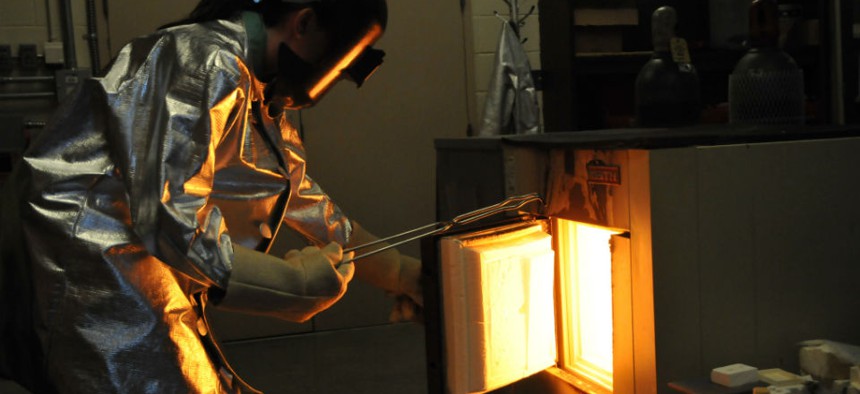
A Naval Surface Warfare Center scientist tests materials at the Carderock Ceramics Lab in Maryland. Nicholas Malay/U.S. Navy
Erosion of DOD’s Technical Workforce Has Broad Consequences
The military risks losing skilled scientists and engineers who aren't driven by profit.
U.S. defense laboratories and Navy warfare centers face many challenges that threaten their effectiveness at a time when their need is critical. The labs and warfare centers can support programs for new and enhanced capabilities directly or through partnerships with industry, while driving cost out of the acquisition process.
One of our strategic priorities must be our people. It is imperative that we rebuild our science and engineering workforce; nearly 50 percent of whom are within a few years of retirement.
Historically, contributions from Navy labs have enabled the Navy to get best-cost and acceptable risk in applying emerging technologies and performance improvements to weapons systems. Such in-house capabilities can bring market forces to bear in sole-source situations. It can also provide stopgap, limited production products when commercial sources are unavailable, and is a critical resource to provide emerging urgent solutions needed by our warfighters. This in-house role is key to ensuring that critical technical knowledge of our weapons systems is preserved. This is extremely important as industry tends to only maintain such knowledge if funded to do so. A result is costly lessons being relearned in future procurements. Finally, a strong government technical team can provide a safety valve when industry ceases to support older weapons systems still in the field.
The Navy laboratory structure ensures a stable, skilled workforce, tempered by experience, and not motivated by profit. Today, this workforce is at risk.
The long-term health of our technical workforce must be a strategic priority for DOD. To continue to build the competence of our workforce, we must have our scientists and engineers doing meaningful, hands-on work, not simply overseeing industry.
All Navy and Defense labs exhibit an aging workforce with demographics similar to ours at the Naval Air Warfare Center Weapons Division. If we are not aggressive in hiring during the next decade, our workforce size will continue to shrink to unacceptable levels and the critical skills and experience currently resident in the mature element of our workforce will be lost. Due to the increasing complexity of our weapons systems, it is vital that we have a strong technical team to continue to perform the roles both the warfighter and the taxpayer expect.
It is increasingly important that we find more meaningful work to engage our workforce. This will not only help us train the next generation, but will also help improve hiring and retention. Hiring remains a challenge for the warfare centers but there are new tools available to us.
The 2014 National Defense Authorization Act, Section 1107, is one such tool. It gives DOD labs limited direct-hire authority for scientists and engineers with bachelor’s degrees. This authority is especially important for hiring mid-career professionals. These hires address the “bathtub” in our workforce demographics. Section 1107 also provides a capability to build technical career paths above GS-15 level.
The challenge of rebuilding the government technical workforce is amplified because industry, especially the defense weapons sector, has similar demographics. If we don’t act soon, we will have both a hollow defense industrial base and a hollow government defense team; both sectors will struggle with inexperienced personnel as our systems continue to grow in complexity. This makes it crucial that government learn to partner more effectively with industry.
It is our belief that government labs and warfare centers remain an untapped resource in our efforts to improve the acquisition of military goods and services. We believe a focused discussion on work, people and infrastructure is an imperative in these fiscally challenging times. We need a deliberate DOD workforce rebuilding strategy that starts with long-term stable hiring authority.
Rear Adm. Michael Moran is commander of the Naval Air Warfare Center Weapons Division and assistant commander for test and evaluation at Naval Air Systems Command. Scott O’Neil is the executive director of the Naval Air Warfare Center Weapons Division and director for research and engineering at Naval Air Systems Command. The views expressed are their own.






